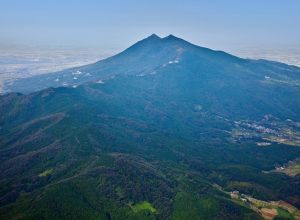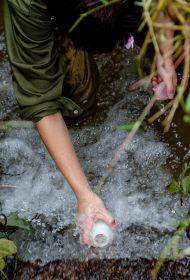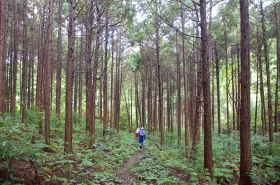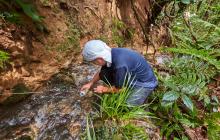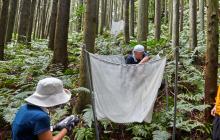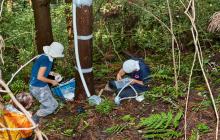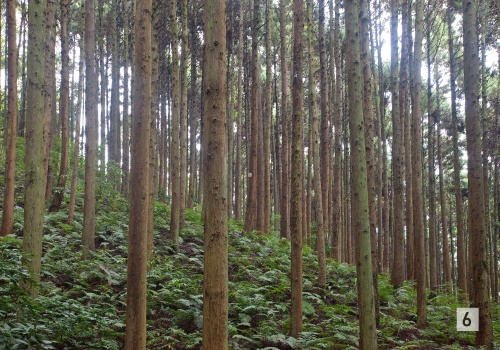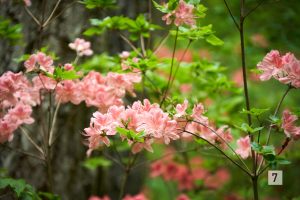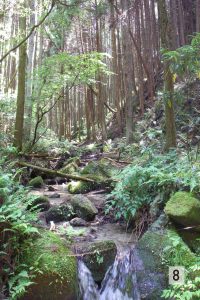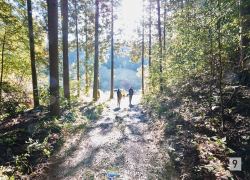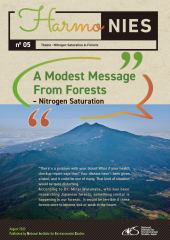HarmoNIES No.5
A Modest Message From Forests
A Modest Message From Forests
- Nitrogen Saturation
“There’s a problem with your blood! What if your health checkup report says that? Your disease hasn’t been given a label, and it could be one of many. That kind of situation would be quite disturbing.
According to Dr. Mirai Watanabe, who has been researching Japanese forests, something similar is happening in our forests. It would be terrible if these forests were to become sick or weak in the future.
Keywords: nitrogen saturation, planted forest, stream water
"The overabundance of nitrogen in the stream water may seem currently to be a modest message from the forests, "
According to Dr. Mirai Watanabe, who has been researching Japanese forests, something similar is happening in our forests. I thought that forests are naturally filled with fresh air and that the water in their small streams is cool and clear, refreshing our bodies and clearing our heads. It would be terrible if these forests were to become sick or weak in the future.
In the area where Dr. Watanabe grew up, there was a rich forest, which was his playground, his way to school, and a part of his life. The colors of the forest were beautiful in every season: Pale-colored spring with blooming flowers, blazing green in summer, brown in fall, and gray in winter. For Dr. Watanabe, the forest was not someone else’s story. Even if, unlike him, we don’t have daily contact with a forest, we can’t remain ignorant and indifferent.
What Is Happening In Our Forests?
To begin with, nitrogen on the earth is circulating. And when nitrogen in the air (N2) is converted into compounds such as ammonia (NH3) and nitric acid (HNO3), trees and organisms can use it to sustain life. After death of these organisms, bacteria and other microorganisms decompose these nitrogen compounds and turn them back into the air as nitrogen gas. But in the forests near cities, nitrogen compounds are present in excess of the amount what the forest ecosystem needs, and they flow into the stream water as nitrate.
Is This Excess Nitrogen a Problem?
When it occurs in the air, it is called air pollution. Various measures are being developed to deal with this, as it is already known to have a negative impact on both the environment and human health. But what if there is too much nitrate in the stream water? According to Dr. Watanabe, this means that a lot of nutrients flow into our rivers, lakes and ponds. This isn’t a good thing at all: It causes an imbalance in the ecosystem, making it difficult for fish and various other organisms to live. Also, if the nitrate are carried into the groundwater and are accumulated, the groundwater can become unsafe to drink. (although tap water is properly treated, so you don’t have to worry about drinking it.)
In summary, high nitrate levels in stream water may not be an immediate problem now, but it’s a situation that requires great caution, Dr. Watanabe explained. This is hardly a healthy state of affairs, to say the least.
Where Does the Nitrate Come From?
Keeping Our Forests Healthy
Dr. Watanabe has been investigating the forests around Mount Tsukuba. He has conducted a statistical analysis based on steepness and other geographical features and tree species to find factors that cause high nitrate concentrations in stream water.
As a finding, he discovered that the stream water in broad-leaf forests has nitrate concentrations lower than those in needle-leaf forests. The results of these studies may make an important contribution to the future health management of forests; this may include the planting of broad-leaf trees.
Future of Research
Forests support all living things by purifying air and water, and we hope that they will continue to do so. Dr. Watanabe is continuing his research with the aim of deepening his understanding of forests and becoming in able to interpret forest health checkups—in other words, to be able to recognize and cure any problems that may arise, even if the results of his efforts don’t become apparent for decades or centuries from now.
Planted Forests
Japanese forests are dominated by cedar trees. Cedar and cypress trees have historically been planted, and now about 40 percent of our forests are planted. Japanese cedar is endemic to Japan; it grows quickly and straight and is easy to process.
Planted forests can grow thick, good trees if they are thinned out and well managed, in the same way that cropland need to be cared for. However, recently, the number of people managing our forests has been decreasing, and some forests are being left unattended. If the forests are not cared for, they will become dark and crowded with thin, weak trees; this can easily lead to landslides and other disasters in the event of heavy rains. A wide range of living creatures are living in mangrove forests. These photos are just a few example.
Photo 6: Cedar plantation
Photo 7: Blooming Torch Azalea
Photo 8: small stream in a forest
Continuing on Despite Severe Pollen Allergies
Related Papers
- Watanabe M, Miura S, Hasegawa S, Koshikawa KM, Takamatsu T, Kohzu A, Imai A, Hayashi S (2018) Coniferous coverage as well as catchment steepness influences local stream nitrate concentrations within a nitrogen-saturated forest in central Japan. Sci. Total Environ., 636, 539–546.
- Nishina K, Watanabe M, Koshikawa KM, Takamatsu T, Morino Y, Nagashima T, Soma K, Hayashi S (2017) Varying sensitivity of mountainous streamwater base-flow NO3– concentrations to N deposition in the northern suburbs of Tokyo. Sci. Rep. 7: 7701.
- Watanabe M (2021), Nitrogen Saturation in Forest Ecosystem and Its Impacts on Environmental Water Quality: Special Feature: Current Status and Assessment of Ecosystem Impacts from Acid Deposition. JOURNAL of ENVIRONMENTAL CONSERVATION ENGINEERING (Japanese), 50, 256–261.
Coverphoto and Photo1, 2, 6: Masami DAITO, 3, 4, 5, 7, 9: Seiji NARITA, 8: Mirai WATANABE
Download PDF
Inquiry
International Coordination Office, Planning Division
National Institute for Environmental Studies
16-2 Onogawa, Tsukuba, Ibaraki 305-8506, Japan
e-mail: int-pub{a}nies.go.jp

